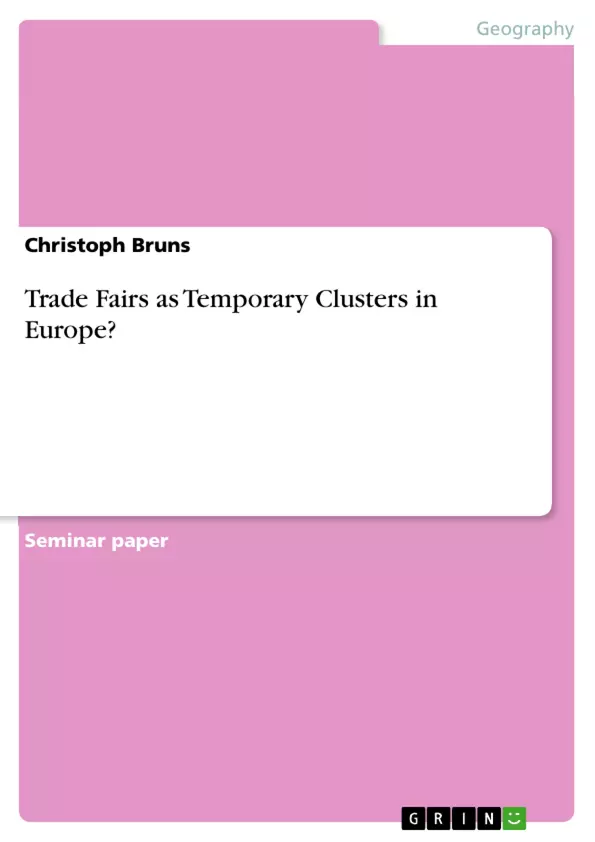In our globalized world trade fairs are important events for firms to communicate and/or sell their products and services to a global audience. But besides this original aim of trade fairs, scientists go further and focus on the effects, which these temporary and spatial accumulations of professionals from the same or equal industries might have. According to that, a particular focus lies on inter-organizational learning processes, like they can be found in clusters. Thus, the central question of this report derives, whether in the European context trade fairs can be seen as temporary clusters, which would imply that trade fairs became central nodes connecting global economy.
This issue is important, since both participating in trade fairs and searching for adequate interaction partners are costly and time intensive processes. If trade fairs provided equal benefits as temporary clusters, organizing and participating entities would expend more effort on planning and conducting the time before, during and after the trade fair. Apparently, benefiting from new knowledge pools is at least an important aspect in times of increasing innovation velocity.
Finding a clear answer for the problem is not trivial, since the majority of available literature focuses on trade fairs in the context of a communication instrument in firm’s marketing mix. Furthermore there are difficulties to maintain a particular focus on Europe, since globalized world economy meets on international flagship trade fairs. Another aspect is the difficulty of measuring qualitative and quantifiable effects of spatial proximity in clusters, which additionally could be implemented to compare different forms of temporary clusters.
Inhaltsverzeichnis (Table of Contents)
- 1. Introduction
- 2. Trade Fairs
- 3. Temporary Clusters
- 3.1 Structure
- 3.2 Local Buzz
- 3.3 Pipelines
- 4. Trade Fairs as Temporary Clusters
- 4.1 Structure
- 4.2 Information and Knowledge Creation
- 4.2.1 Monitoring and Comparing
- 4.2.2 Buzz and Global Pipelines
- 5. Implications for the European Economy
- 6. Conclusion
- Bibliography
Zielsetzung und Themenschwerpunkte (Objectives and Key Themes)
This report explores the potential of trade fairs to act as temporary clusters in the European context. The main objective is to analyze whether trade fairs provide the same benefits as traditional clusters, particularly in terms of inter-organizational learning and knowledge creation. Key themes include:- The role of trade fairs in facilitating communication, product/service exchange, and knowledge sharing within industries.
- The concept of temporary clusters and their characteristics, particularly in relation to spatial proximity and information exchange.
- The comparison of trade fairs to traditional clusters in terms of structure, information generation, and knowledge creation.
- The implications of trade fairs as temporary clusters for the European economy, considering the costs and benefits of participation.
Zusammenfassung der Kapitel (Chapter Summaries)
Chapter 1: Introduction
This chapter introduces the research question, which examines whether trade fairs can function as temporary clusters in Europe. It highlights the importance of inter-organizational learning and knowledge creation in today's rapidly changing innovation landscape. The chapter also addresses the challenges of studying this topic, including the focus on trade fairs as a marketing tool, the difficulty of measuring qualitative and quantitative effects, and the need for a European perspective in a globalized context.Chapter 2: Trade Fairs
This chapter provides a definition of trade fairs as recurrent, temporally limited market events that facilitate communication and exchange within specific economic sectors. It emphasizes the importance of geographical proximity and face-to-face interaction for knowledge sharing and learning within industries. The chapter also explores different types of trade fairs based on geographic and market coverage.Chapter 3: Temporary Clusters
This chapter focuses on the concept of temporary clusters, outlining their structure, local buzz, and the creation of pipelines for information and knowledge exchange. It describes how temporary clusters facilitate inter-organizational learning and knowledge creation, which are crucial for innovation and competitiveness.Chapter 4: Trade Fairs as Temporary Clusters
This chapter examines the potential for trade fairs to function as temporary clusters. It analyzes the structural similarities and differences between trade fairs and traditional clusters, paying particular attention to the processes of information and knowledge creation. The chapter also explores how trade fairs can foster monitoring, comparison, and the development of global pipelines for innovation.Chapter 5: Implications for the European Economy
This chapter discusses the implications of trade fairs as temporary clusters for the European economy. It considers the costs and benefits of participating in trade fairs, as well as the potential impact on innovation, competitiveness, and regional development.Schlüsselwörter (Keywords)
The key concepts and terms explored in this report include trade fairs, temporary clusters, inter-organizational learning, knowledge creation, information exchange, spatial proximity, European economy, innovation, and competitiveness.- Arbeit zitieren
- Christoph Bruns (Autor:in), 2011, Trade Fairs as Temporary Clusters in Europe?, München, GRIN Verlag, https://www.grin.com/document/205776



